
aboriginal rafts and canoes, 1770
| home | catalogue | history | references | appendix |
 |
surfresearch.com.au
aboriginal rafts and canoes, 1770 |
| Rafts | Rolled-Bark and
Reed Catamarans - Tasmania |
| Tied-Bark Canoes - East Coast Australia | Thomas
Dick Photographs - Macleay
Valley, c1910. |
| Sewn
Bark Canoes - North Coast
Australia
[Awaiting content] |
Dugout and Bark Canoes - North Coast Australia |
| Museum Collections | |
| Fishing | References |
| 1818 Phillip Parker King: Raft rider, off Lewis Island, Northern Australia. - King: Western Coasts of Australia (1827), title page. |
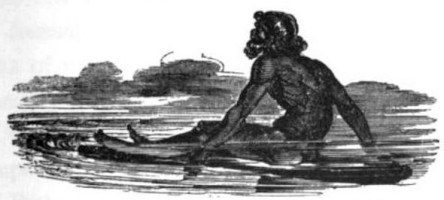 |
| 1819 Number 56: View of Goold Island and Mount Hinchinbrook from Rockingham Bay. Etched by P. P. King A aboriginal paddles his very small raft across a wide bay. Phillip Parker King - album of drawings and engravings, 1802-1902. State Library of NSW http://www.acmssearch.sl.nsw.gov.au/search/itemDetailPaged.cgi?itemID=442570 |
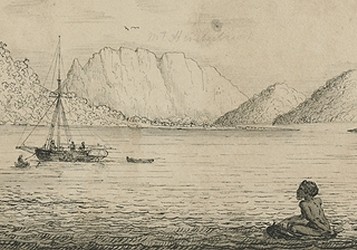 |
| 1821 Number 4a: Aboriginal Raft , Hanover Bay, 1821. Phillip Parker King - album of drawings and engravings, 1802-1902. State Library of NSW http://www.acmssearch.sl.nsw.gov.au/search/itemDetailPaged.cgi?itemID=442570 |
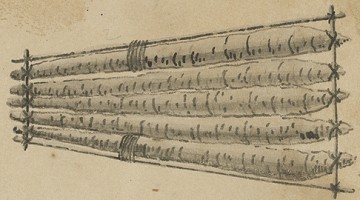 |
| 1821 Number 94a: Raft and Aborigines, Hanover Bay, 1821. Phillip Parker King - album of drawings and engravings, 1802-1902. State Library of NSW http://www.acmssearch.sl.nsw.gov.au/search/itemDetailPaged.cgi?itemID=442570 |
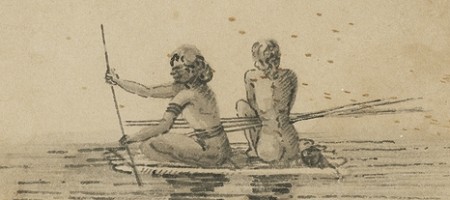 |
| 1844 This unusual floating wurly was a primitive watercraft seen on the Murray River about 1844. [George French Angas?] - State Library of South Australia (Archives Department) It is likely that there two, or more, wurlies (rafts) in the illustration. - Edwards: Bark Canoes of the Murray Valley (1972) page 9. |
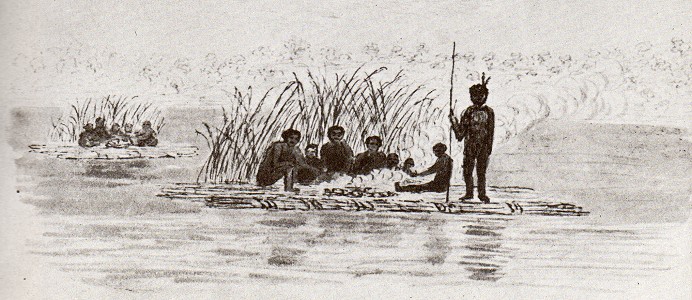 |
| 1844 Native Raft, Roe Islands, King Sound, WA. -Stokes, J. Lort, Stanley., Owen: Discoveries in Australia, Volume 1. T. and W. Boone, London, 1846. |
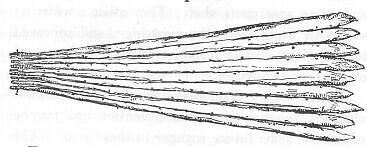 |
| 1850 Number 9a. Catamaran and Rider, Bruinie [Brumer] Island, New Guinea, detail and adjusted. While not from
the Australian mainland, this three log design
provides the template for the rolled-bark or reed
canoe of Tasmania, see below.
The similarity with the Madras catamaran is remarkable, except for the decorative sculptured prow as used in New Guinea. Oswald W.B. Brierly : New Guinea coast and Cape York area during the voyage of H.M.S. Rattlesnake, ca. 1849-1850. State Library of NSW |
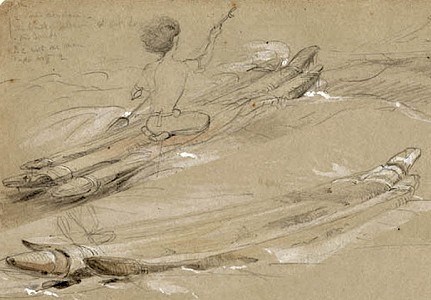 |
| 1916 Worora youth on a mangrove tree raft (or 'kaloa'), George Water, Western Australia, 1916. Photograph by Herbert Basedow (1 of 2). - Basedow, Herbert: The Australian Aboriginal. F. W. Preece & Sons, Adelaide, 1925, plate 22. National Museum of Australia http://www.nma.gov.au/collections-search/display?irn=11791 |
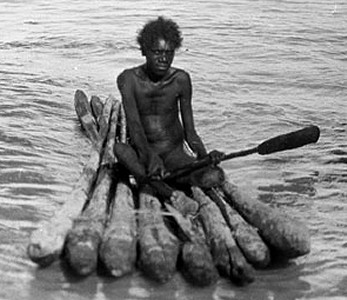 |
| 1931 A model raft made from six cylindrical wooden rods, collected in 1931 by Gerhard Laves from Bardi people at Cape Leveque, WA. Description: A model raft made from six cylindrical wooden rods with pointed ends and joined together with thread. A second "deck" of five pointed cylindrical wooden rods are attached to the first with a metal nail. National Museum of Australia http://www.nma.gov.au/collections-search/display?irn=16523 |
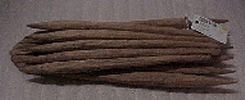 |
| 1931-1994 Double triangular raft, pole and paddle, Western Australia. Illustration by Xiangyi Mo. - Barlow: Aboriginal Technology: Watercraft (1994) page 27. The illustration by Xiangyi Mo is possibly based on the model raft held by the NMA, above. The logs are pinned, and not bound, the grass matting is represents a seat, and below are a punting-pole and a short-staffed spoon or pudding-stirrer paddle, as used by George Water in the above photograph. Their use throughout the continent and Tasmania indicates the pudding-stirrer's great antiquity, perhaps back to the early voyages from SE Asia. |
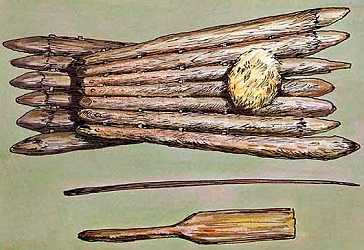 |
| 1940 Aboriginal fishermen on boats in the North-West The two rafts in the foreground are double mangrove tree rafts, or kaloa, as described above. A dugout canoe is in the background. From the Frank Bunney collection of photographs taken mainly in the North-West ; published or produced 1918-1951, with the majority from 1930 to1939. State Library of Western Australia
|
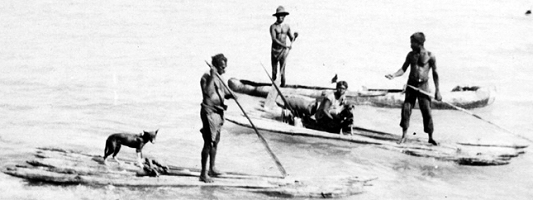 |
| 1945 River beauties, Daly River, NT. 1 January 1945.
Boerner Collection, Photo No: PH0764/0095 ,
Description:
Front of photo notes 'Daly River NT 45 (Paper Bark Canoe)', depicting two women and two dogs on a paper bark canoe. Likely a raft mostly of paper bark branches mixed with other plant material, see below: Wooden raft from Sydney Island, Gulf of Carpentaria, 1965. Museum Collections Northern Territory Library http://hdl.handle.net/10070/8897 |
| c1802 Nicholas Petit: Van Dieman's Land Aborigines carrying fire in their canoe, 1802. - Museum d'Historie naturelle, Le Harve. - Muekee and Shoemaker: Aboriginal Australians (2004) page 18. From the voyage by Peron and Freycinet. Also see a Reproduction in Hobart Museum. |
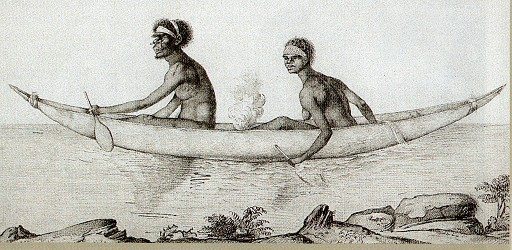 |
| 1803 Campfire and rolled-bark or reed fishing canoes, Tasmania, 1803. Nicholas Petit: View of Schouten Island, Van Diemen's Land, 1803 - Museum d'Historie naturelle, Le Harve. - Muekee and Shoemaker: Aboriginal Australians (2004) page 13. - Burnum: Burnum Burnum (1988) page 267. |
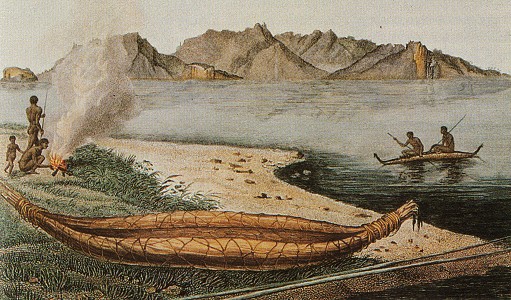 |
| Louise de Sainson : A canoe made from bark [Tasmania], 1830. Pirogue aus zusammengenaketer baumrinde Louis Auguste de Sainson (1800-1887) was in Australia and the Pacific in 1826-1829. At the National Gallery of Australia NGA 2011.58 Hand coloured print titled: Pirogue en ecorce cousue, [Sewn bark canoe],1834 |
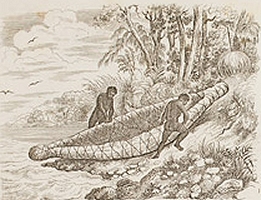 |
| 1843 Model of a Tasmanian canoe in the Pitt Rivers Museum, Oxford, such as were used by the Aborigines to "cross to Maria Island and islets in the vicinity of the mainland." Brought from Australia, in 1843, by Sir John Franklin and presented to Eton College. - Roth, Henry Ling: The Aborigines of Tasmania (1899) facing page 153. Roth rightfully suspected that the ends of the model had been significantly elevated during storage or in dispatch, and the model was not intended to have this extreme curvature. University of Tasmania http://eprints.utas.edu.au/6471/1/b2_1_aborig_canoe_baskets.jpg |
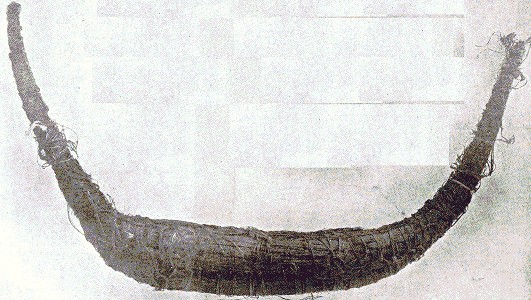 |
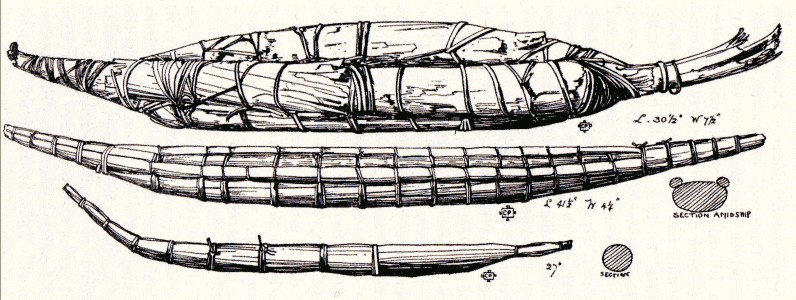
| 1770 Sidney Parkinson: Australian Aborigines' canoes, Botany Bay,1770 [detail]. - The Trustees of the British Museum, photograph by Michael Holford. - Rienits: Voyages of Captain Cook (2004) page 49. |
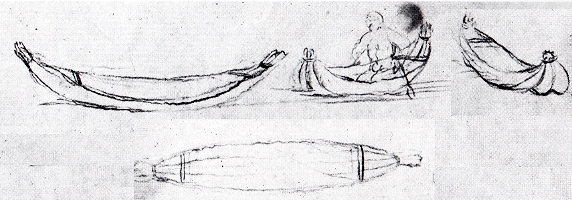 |
| 1788 (1789) A View of Botany Bay, detail. Medland, Thomas,1755-1822, engraver. Cleveley, Robert,1747-1809,artist. Robert Clevely did not visit Australia, however his brother James was as a carpenter on Cook's third voyage and through him, Robert obtained some of the illustrations compiled on the three voyages. Clevely's illustrations appear to be based on Sidney Parkinson's sketches of 1770 (above), and in the image (left), the position of the paddler is obviously incorrect. |
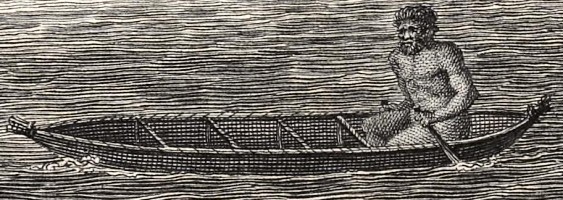 |
| 1788 View of Port Jackson, detail. Shows group of Aborigines in canoes. Prattent, T., engraver. Cleveley, Robert,1747-1809, artist. - Phillip, Arthur: Voyage to Botany Bay (1789) opposite page 62. |
 State Library of Victoria :
http://handle.slv.vic.gov.au/10381/266724
|
|
1788 (1789)
Natives [Aboriginal Australians] of Botany Bay, detail. Shows three Aboriginal men, hunting with a barbed-spear, fishing, with hook and line, and the third with short pudding-stirrer paddles. Medland, Thomas,1755-1822, engraver. Cleveley, Robert,1747-1809, artist. - Phillip, Arthur: Voyage to Botany Bay (1789) opposite page 82. State Library of Victoria State Library of NSW (coloured print) Series 01: Views of Australasia : album of prints from various sources, some hand coloured, ca. 1773-1848 94. R. Cleveley: Natives of Botany Bay |
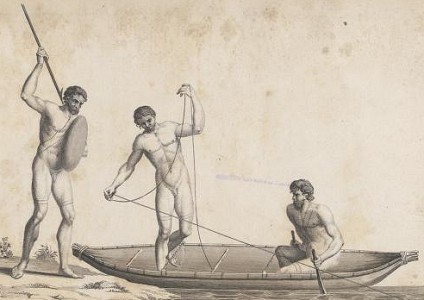 |
| 1788 First encounter with Aborigines at Port Jackson in 1788 [ Manly Cove]. - Bridgeman-Giraudon - Muekee and Shoemaker: Aboriginal Australians (2004) page 15. Governor Phillip visited and named Manly Cove, befitting the "confidence and manly behaviour" of the local aboriginals, on 21 January 1788. In November he returned when a large number of aboriginals had assembled to feast on a stranded whale, that had been in the harbour for a number of days. |
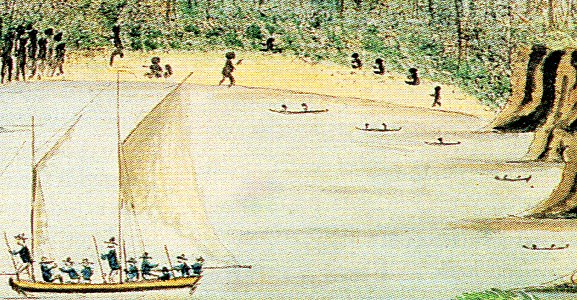 |
| 1800 Pimbloy [Pemulwuy]: Native of New Holland in a canoe of that country. Samuel John Neele 1758-1824, engraver. The amount of freeboard, compared to all other contemporary images, is exaggerated. However, note - Grant, James: Voyage in the Lady Nelson (1804) opposite page 170. State Library of Victoria. http://handle.slv.vic.gov.au/10381/255652 |
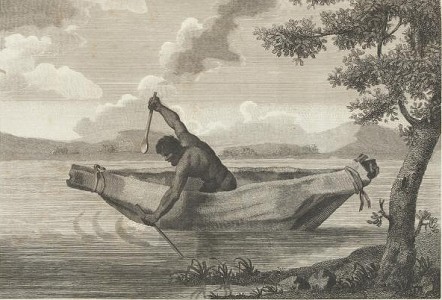 |
| 1800 "Port Jackson Painter": Canoes at Port Jackson, 1800 [three illustrations] - The Trustees of the British Museum. - Edwards: Bark Canoes of the Murray Valley (1972) page 7. a. Campfire and fishing canoes, Port Jackson, 1800 |
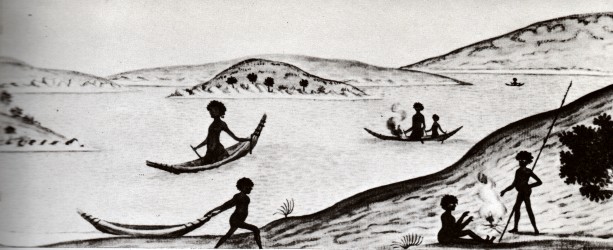 |
| b. Fishing
canoe , Port Jackson, 1800 |
 |
| c. Four
bark canoes, Port Jackson, 1800 |
 |
| c1800 Unknown: Natives fishing with the Fiz-gig, circa 1800. An fiz-gig is a pronged fishing spear. Illustration from Ida Lee: The Coming of the British to Australia 1788 to 1829. (1906), Chapter 1, plate 12. |
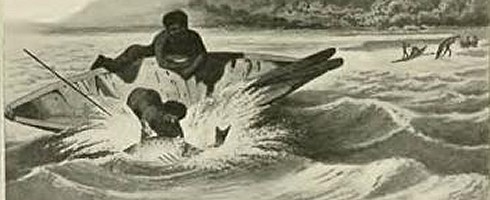 |
| 1802 During their voyage of discovery in 1802 the French navigators Peron and Freycinet found the Aborigines at Port Jackson, New South Wales,making extensive use of bark canoes. From a lithograph by Charles Lesueur. [Photograph from Voyage de Decouvertes Aux Terres Australes, M. F. Peron (Atlas par Mm.Lesueur - Edwards: Bark Canoes of the Murray Valley (1972) page 7. |
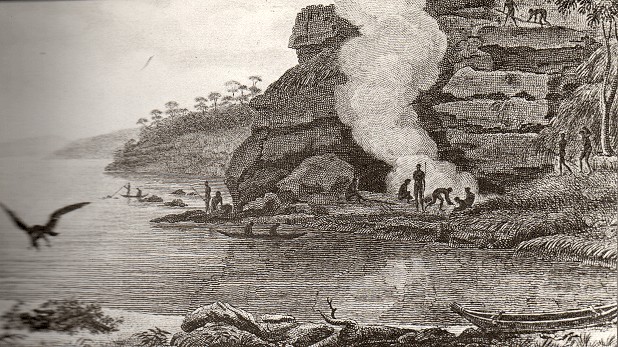 |
| 1802 Tied bark canoes in use at at Port Jackson, New South Wales, 1802. - Photograph from Voyage de Decouvertes Aux Terres Australes, M. F. Peron (Atlas par Mm.Lesueur - Edwards: Bark Canoes of the Murray Valley (1972) page 8. Internet Archive https://archive.org/details/voyagededcouve03pr |
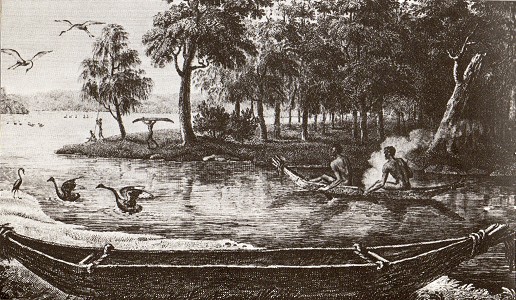 |
| 1805 Number 11: Aboriginal female fishing from a bark canoe, [Port Jackson]. Attributed to George Charles Jenner and W.W. [William Waterhouse] Australian Aborigines, pre 1806. State Library of NSW http://www.acmssearch.sl.nsw.gov.au/search/itemDetailPaged.cgi?itemID=447340 |
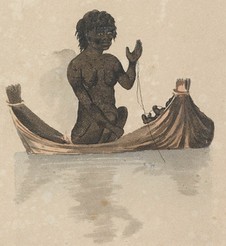 |
| 1810 Barrington, George: Vignette of an Aboriginal woman fishing in a canoe. The fishing rod is incorrect, and fishing was with a hand line only. An Account of a Voyage to New South Wales M. Jones and Sherwood, Neely & Jones, London,1810., title page. National Library of Australia http://nla.gov.au/nla.pic-an7896959 |
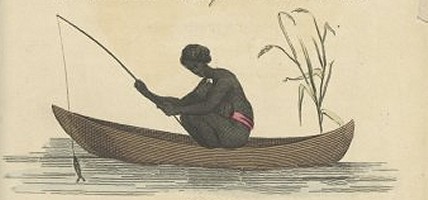 |
| 1812 John Eyre: Aboriginal fishers and canoes at Cook's Point, Botany Bay (detail). Mitchell Library, State Library of New South Wales. Views in New South Wales, 1813-1814 [and] Historical account of the colony of New South Wales, 1820-1821 John Eyre: Botany Bay Harbour, taken from Cook's Point |
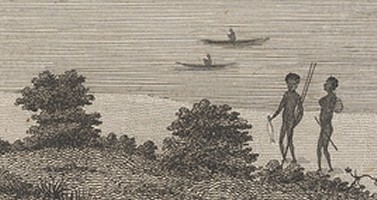 |
| 1815 Number 1: Natives fishing in a bark canoe, [Port Jackson]. Attributed to R. Browne. Drawings of Aboriginal Australians, ca 1813-1819. State Library of NSW http://www.acmssearch.sl.nsw.gov.au/search/itemDetailPaged.cgi?itemID=411337 |
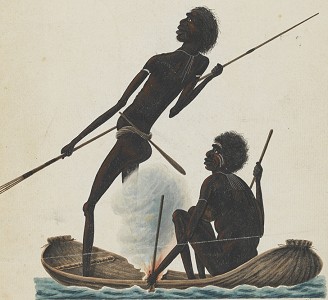 |
| 1817 Lycett, Joseph: Fishing [Port Jackson?], 1817. Aborigines spearing fish, others diving for crayfish, a party seated beside a fire cooking fish. National Library of Australia http://nla.gov.au/nla.pic-an2962715-s17 - Burnum: Burnum Burnum (1988) page 35. Note the tied-bark canoes, spear-fishing, and the three aboriginals at the left who are diving, swimming, and returning to shore with a catch of crayfish. |
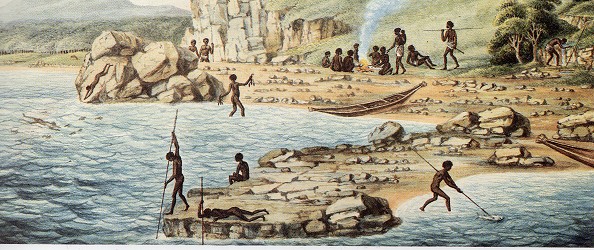 |
| 1817 Lycett, Joseph: Fishing by torchlight, other Aborigines beside camp fires cooking fish, 1817. National Library of Australia http://nla.gov.au/nla.pic-an2962715-s8 |
| 1819 Turtle Fishing [from bark canoes] at Endeavour River, North Queensland, 1819. - King: Western Coasts of Australia (1827), page 245. |
 |
| 1819 [Bark] Canoes at Goold Island, Northern Australia, 1819. Reported as about 5 ft long and paddled with a strip of bark. - King: Western Coasts of Australia (1827), page 200. |
 |
|
1826 Canoe of Jervis Bay, New Holland by (Francois-Edmond) Paris. Pirogue de la Baie Jervis, Nouvelle Holland par Paris, 1826. Plate 112 |
 |
|
1829 State Library of Victoria Watercolour; 25.5 x 39 cm. on cream
board mount 44 x 51 cm. |
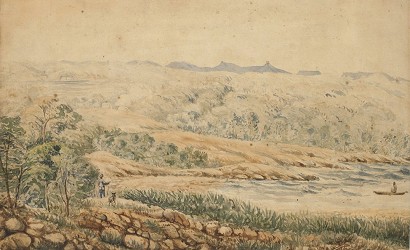 |
| 1835 Number 56: Natives fishing in a bark canoe, NSW, detail. Govett, William: Notes and sketches taken during a surveying Expedition in N. South Wales and Blue Mountains Road, 1830-1835. State Library of NSW http://www.acmssearch.sl.nsw.gov.au/search/itemDetailPaged.cgi?itemID=824687 |
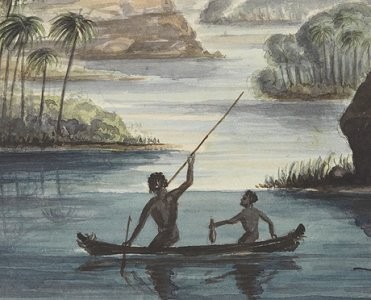 |
| [1835] The Enterprize in the Yarra. Frederick B. Schell (1838 - 1900): An American artist, Schell was active in Australia from 1886-1889. Copy of ink and watercolour drawing by the artist Frederic B. Schell, based on sketches by W. F. E. Liardet. An engraving of Schell's drawing appears in the Picturesque Atlas of Australasia, vol. 1, page 164 (Sydney, 1883-1886). State Library of Victoria Image H15361/37 |
| 1844 Number 8: Twofold Bay Canoe. An almost identical design to that of Jervis Bay, above. Brierly O.W.: Sketches made in Australia (1842-1844) |
 |
| 1844 Number 10a: Native [Aboriginal] and canoe, Twofold Bay, NSW. Brierly O.W.: Sketches made in Australia (1842-1844) State Library of NSW |
 |
| c1840? This picture of fishing canoes on the Murray River shows how Aborigines used their heavy spears to propel these simple craft. - The Natural History of Man, page 31. - Edwards: Bark Canoes of the Murray Valley (1972) page 31. |
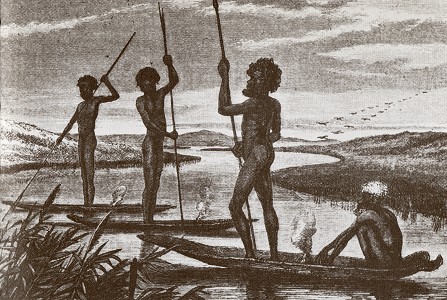 |
| 1847 George French Angas: Murray River Aborigines in a bark canoe. South Australia Illustrated, South Australian Museum. - Burnum: Burnum Burnum (1988) page 35, detail. Angas wrote: Their canoes are nothing more than frail sheets of bark, moulded into a hollow shape by means of heat and steam, the ends and orifices are stopped with clay, and in the centre is a small fire, raised upon a heap of wet weeds and sand; over this fire they frequently cook their food whilst on the water; although upset by the slightest breath of wind, the natives are wonderfully expert in the management of these rude and frail canoes. For an alternative version of the illustration, see: Angas: Scenes in Australia and NZ (1847) plate 30? State Library of South Australia |
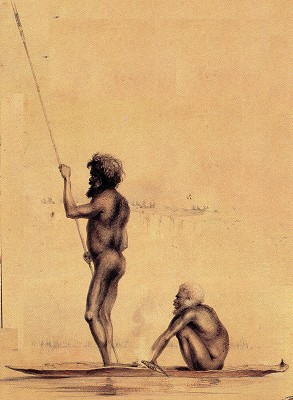 |
| 1860-1862 Tommy Barnes: Fish-spearing, Fig. 253, detail. Tommy Barnes: Man in a canoe catching a turtle, Fig. 254, detail and adjusted. drawings with pen and ink by an untaught Aboriginal lad of the Upper Murray, known as "Tommy Barnes." ... There is much spirit in these drawings, the attitudes of some of the figures, and the faces of some of the women, are very good. If carefully examined, I think we cannot avoid the conclusion that Tommy Barnes is a close observer, and is possessed of some artistic skill, which, if cultivated, would have enabled him to draw well. These sketches were hastily drawn, with no particular object in view, and probably only for his own amusement, pages 257-258. -Smyth, Robert Brough: The Aborigines of Victoria, (1878) pages 257-258. |
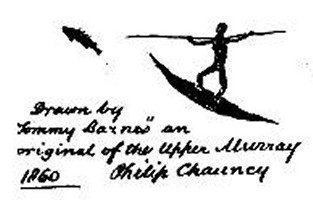 Figure 253 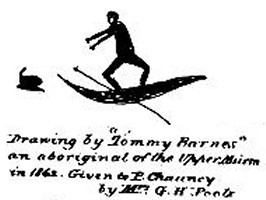 Figure 254 |
| 1860 Number 13: Canoe of the Aborigines, Busby Park [Gippsland, Victoria], 25th November [1860] The hand paddles are shown on the left, adjusted. Eugene von Guerard: Volume 11: Sketchbook XXXII, No. 13-14 Australian. 1860-1861 State Library of NSW |
 |
| 1862 Number 15: Canoe of the Aborigines, Mitta Mitta [North-east Victoria], 3 Nov '62. Eugene von Guerard: Volume 12: Sketchbook XXXIII, No. 15 Australian. 1862 State Library of NSW |
 |
| 1881 Eucalyptus rostrata bark peeled for canoe building. Gabriel Marcel: Australian Aborigines Popular Science Monthly Volume 19, page 683. - |
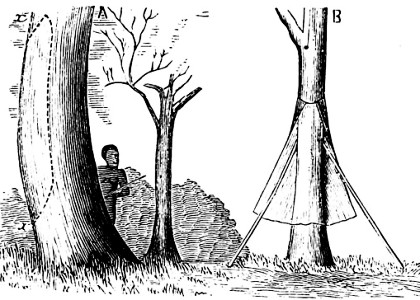 |
| 1886 Lake Tyers [Gippsland, Victoria] people in traditional bark canoes, 1888. - from the Riley Collection, National Library of Australia. - Burnum: Burnum Burnum (1988) page 307. |
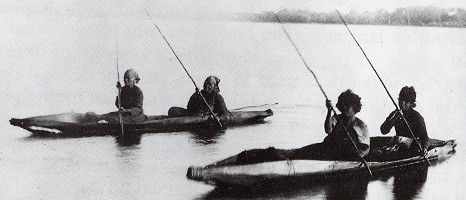 |
| c1887 One of the canoes issued by the Government of south Australia for use by Aborigines on the lowwer Murray River and on lakes Alexandria and Albert. -Illustrations from the Taplin Collection in the South Australian Museum - Edwards: Bark Canoes of the Murray Valley (1972) page 61. |
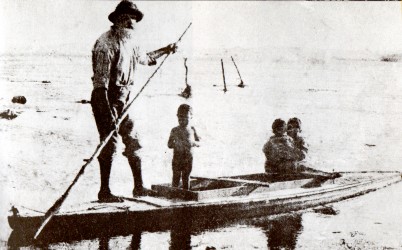 |
| 1888 Tied bark canoes on Lake Tylers, Gippsland, Victoria, about 1888. -National Library of Victoria, photograph by Mr. N. C. Caire. - Edwards: Bark Canoes of the Murray Valley (1972) page 11. |
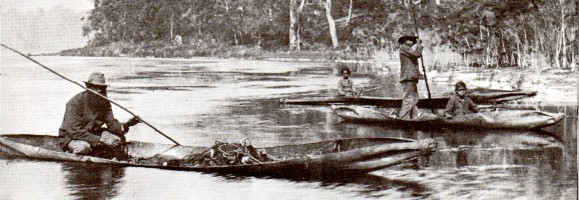 |
| 1888 The Barron River, near Cairns. J.R. Ashton Garran: Picturesque Atlas of Australasia (1886-1888) Part 37, page 402. Julian Rossi Ashton (1851-1942), art teacher and artist, was born in 1883, moved to Sydney to work on the Picturesque Atlas of Australasia until 1886. http://adb.anu.edu.au/biography/ashton-julian-rossi-5073 |
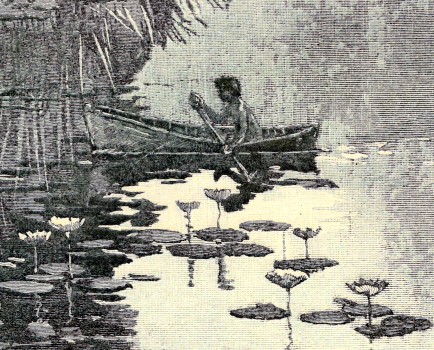 |
| 1888 Dugong Fishing. [Northern Australia] Schellsberson: Garran: Picturesque Atlas of Australasia (1886-1888) page 402. |
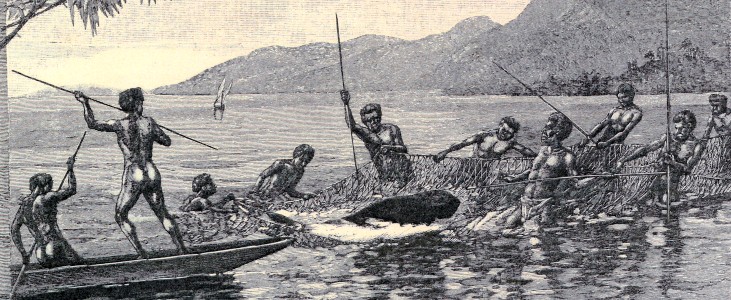 |
| 1888 Making a Bark Canoe. [Inland NSW?] Ellis Rowan Garran: Picturesque Atlas of Australasia (1886-1888) page 711. http://en.wikipedia.org/wiki/Ellis_Rowan |
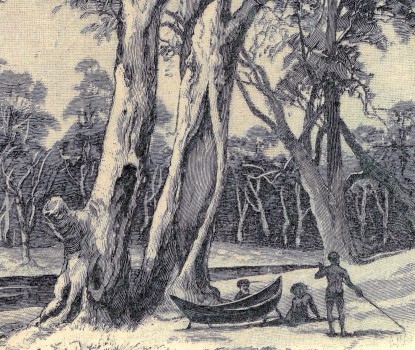 |
| 1910 Thomas Dick: Two Aboriginal men spearing fish from canoe, Port Macquarie. State Library of NSW http://www.sl.nsw.gov.au/itemID=392831 - Burnum: Burnum Burnum (1988) page 75. For a selection of Dick's photographs from the Macleay Valley in the early 1900s, see below. |
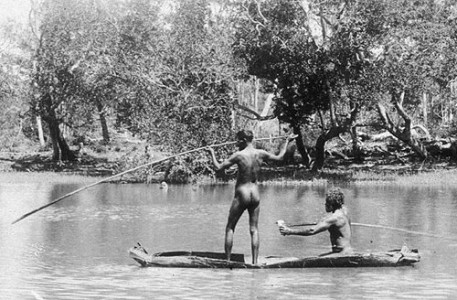 |
| 1962 A unique photograph of a Murray River bark canoe being made in 1962. - State Library of South Australia (Archives Department, photograph by George Burnell) [cropped] - Edwards: Bark Canoes of the Murray Valley (1972) page 28. |
 |
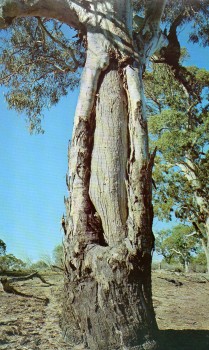 |
Left:
1972 Many centuries ago, the aborigines cut bark for a canoe from this fine red gum at nor-West bend station, near Morgan, South Australia. Photograph: Robert Edwards - Edwards: Bark Canoes of the Murray Valley (1972) page 32. Right: 1988 A canoe tree at Broulee. Photograph: Colin Totterdell - Burnum: Burnum Burnum (1988) page 318. Also see: NSW Office of
Environment and Conservation, 2005.
|
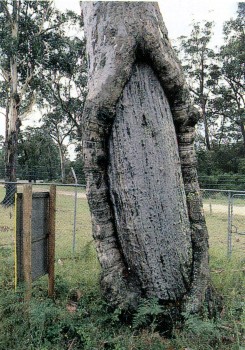 |
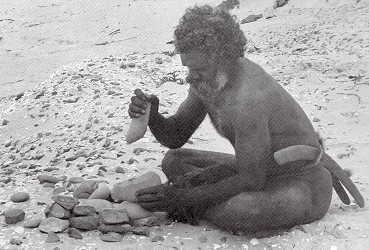 |
Tool construction.
Left: Stone flaking. - Burnum: Burnum Burnum (1988) page 68. Right: Grinding and chipping
flakes.
- Burnum: Burnum Burnum (1988) page 28. |
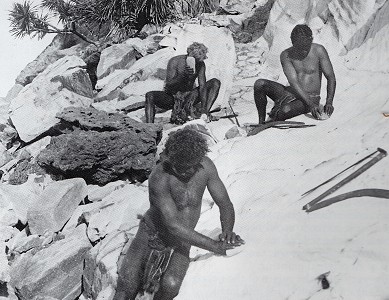 |
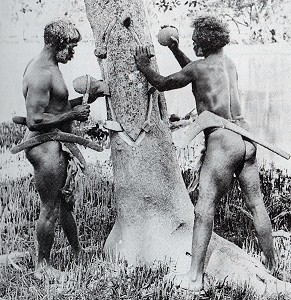 Using
hatchets and stone wedges to
harvest
bark for a shield. |
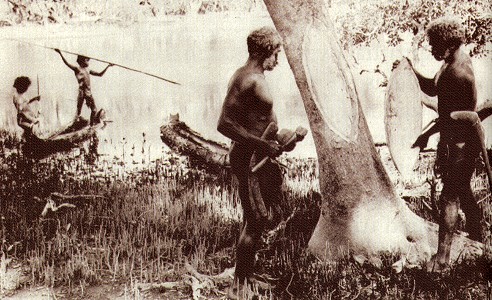 Two
Aboriginal men removing bark from
mangrove tree for shield. State Library of NSW http://www.sl.nsw.gov.au/itemID=392819 - Muekee and Shoemaker: Aboriginal Australians (2004) page 32. |
|
Three methods of
climbing a tree:
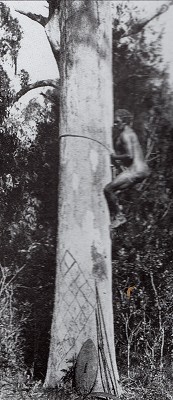 |
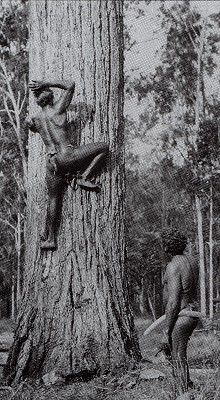 2. Using pegs or wedges. State Library of NSW |
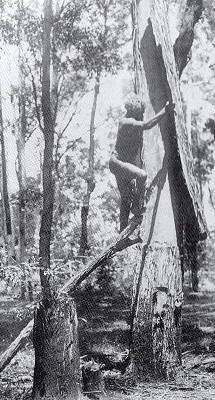 3. Using
a beam, while
removing a
sheet of bark from the tree trunk. |
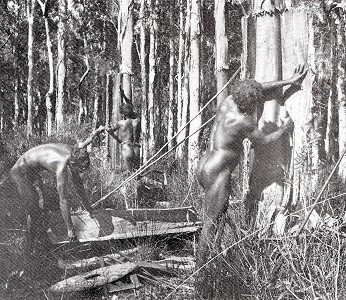 |
Left:
Removing a sheet of bark from the tree trunk. Right: Heating the bark for making a canoe. - Burnum: Burnum Burnum (1988) pages 22 and 75. State Library of NSW http://www.sl.nsw.gov.au/itemID=393076 |
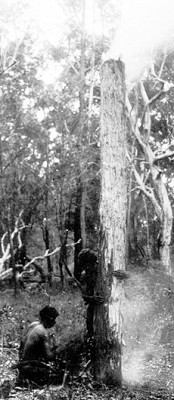 |
| Aborigines forming a bark canoe. After removing a large bark section from a tree, it is held like a flue over a fire, monitored by another, to make it more pliable, above. It is then placed on the ground and the ends prepared for binding. State Library of NSW http://www.sl.nsw.gov.au/itemID=392798 - Burnum: Burnum Burnum (1988) page 75. |
 |
| Two Aboriginal men
spearing fish from canoe, c1905. State Library of NSW http://www.sl.nsw.gov.au/itemID=392831 : Burnum: Burnum Burnum (1988) page 75. Other similar photographs by Thomas Dick are reproduced on pages 31 and 66. |
 |
|
Collecting pippies
on the shore near Port Macquarie.
Photograph: Thomas Dick, Australian Museum. Removed by request of members of the Birpai community. - noted, with thanks, by Vanessa Finney, AM. - Burnum: Burnum Burnum (1988) page 66. |
| Stone
wall fish traps, Barwon
River, Brewarrina, NSW. - Burnum: Burnum Burnum (1988) page 70. The two young Aboriginals in the foreground hold successful catches. The title was adjusted after Corey commented (July 2016): The photo of the
stonewall fishing traps is not in the upper Macleay
River.
It is actually next to the town of Brewarrina, just before Bourke. I have travelled to the spot and it is still structurally there. . See: http://nationalunitygovernment.org/content/ancient-site-australias-outback |
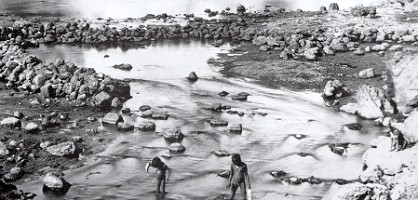 |
| 1818 Phillip Parker King: A sewn bark canoe and stone-headed spear found at Port Essington in April 181. A page from King's Remarks Book, reproduced in: Horden, Marsden: King of the Australian Coast. The Work of Phillip Parker King in the Mermaid and Bathurst, 1817-1822. Melbourne University Press, 1997, plate facing page 90. |
 |
| 1819 Spear Fishing from an Outrigger Canoe, Northern Australia, 1819. - King: Western Coasts of Australia (1827), page 225. |
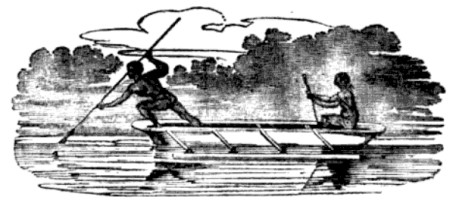 |
| 1888 Spear-Fishing [from Outrigger Canoe, Northern Australia] Schellsberson: Garran: Picturesque Atlas of Australasia (1886-1888) page 402. Note the outrigger canoe. |
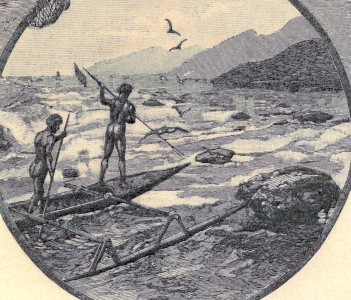 |
| 1935 Outrigger Canoe on the Endeavour River, North Queensland, circa 1935. Courtesy of Keith Kennedy Kennedy was the President of the Anthropological Society of New South Wales. Wilfrid D. Hambly: Primitive Hunters of Australia Anthropology Leaflet 32 [Fieldiana, Popular Series] Field Museum of Natural History, Chigago, 1936, Plate III. https://archive.org/details/primitivehunters32hambl |
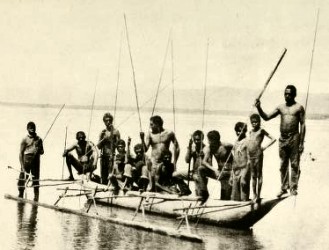 |
| 1870 Canoe - Woi wurrung, Yarra Canoe, Bark, Melbourne, circa 1860s, Reg. No: HT 24782 |
 |
| 1930? Canoe - possibly Hunter valley Reg. No: E 78217 Canoe (A1-98-10) Tied bark canoe with four folds in both ends, and a timber pins. On initial observation, the twine is possibly a natural vine and one of the 4'' timber pins appears to be dowel, possibly replacing the original. There is no evidence of internal struts or supports or binding. There are a significant number of cracks and splitting, and some sections of the hull have possibly warped over time. Photographic material suggests the canoe's construction is similar to that of the Macleay Valley NSW, (Thomas Dick, c1910) and Lake Tylers, Victoria (N. C. Caire, c1888). Dimensions (all approximate): Length: 11ft 4'' - 3450 mm Width: 17.5'' - 230mm @ +12'' - 300 mm Bow: 9'' - 230 mm @ 12'' - 300 mm Stern: 8'' - 200 mm @ 12'' - 300 mm Depth: 6'' - 150 mm Thickness: 0.25-0.5'' - 5-10 mm Photographs: Australian Museum, 6th August 2014 Many thanks to Rebecca Fisher (Australian Museum), David Payne (Australian National MM), and Graham Hinton (Lady Denman MM). 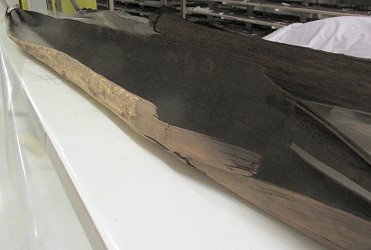 |
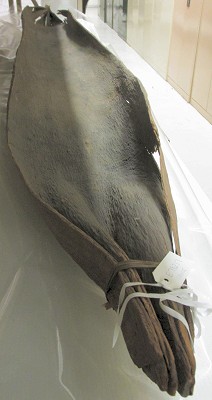 |
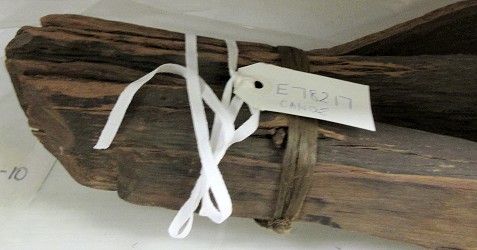 |
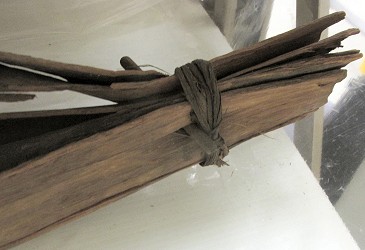 |
 |
Canoe - possibly Hunter valley Reg. No: E 78217 Canoe (A1-98-10) AM Catalogue, 16 Dec 1982. Photograph: unaccredited |
| 1965 Wooden raft from Sydney Island, Gulf of Carpentaria Description: A slightly concave and triangular raft made from long cylindrical wooden logs of variable diameter, lashed together with thick two ply fibre rope. The rope is secured at the distal and proximal end by lashing together underneath the raft. The anterior surface is covered with a thick layer of dried grass to form a level deck. The wooden logs have extensive borer damage. Mornington Island Mission Collection, made in 1965 for a documentary film on traditional hunting and ceremony. National Museum of Australia http://www.nma.gov.au/collections-search/display?irn=180718 |
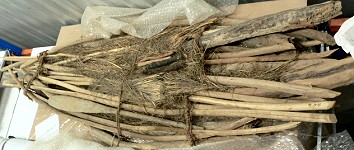 |
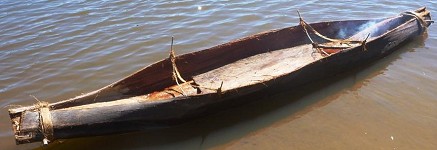 |
2014 Aboriginal Canoe, South Coast NSW. Constructed in association with David Payne and the Australian National Maritime Museum. Sydney, September 2014 Photograph courtesy of David Payne. |
| Stage 2. On the 28th, David Payne supervised the construction of a model of a nawi, to serve as a guide for the building of the full scale vessel. It dimensions are approximately 6ft 5'' x 14'' x 4.5''. |
 |
| Stage 3. On the morning of the 29th the model nawi, the bark, a variety of metal tools, ropes, a portable hearth, a supply of heated freshwater, some tarpaulins, and a few house-bricks were assembled in the Museum forecourt. The modern tool kit; comprising a hammer or mallet, paint scrappers, and a screwdriver; replicated traditional tools of stone, bone or shell and vastly reduced the labour and time. Likewise, the use of hot water to assist the steaming of the canoe ends also significantly compressed construction time. Whereas a nawi was possibly assembled over a number of weeks, here production was reduced to a couple of days. |
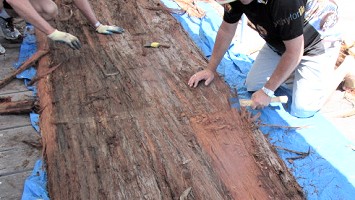 |
| These
areas were progressively thinned,
initially using wedges and mallets to
split the bark at the ends away from the
hard sap wood. The bark was then further separated with scrappers and torn by hand back to the score line. It took about 30 minutes to suitably prepare each end to a thickness between 0.5 - 1''. The removed strips of bark provided fibre for the twisting and plaiting of rope or cord (not shown). |
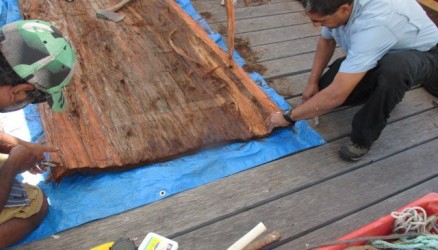 |
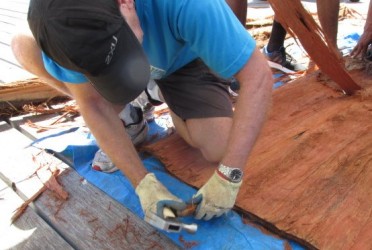 |
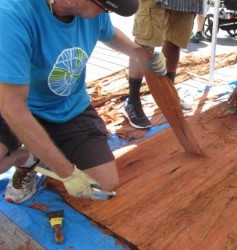 |
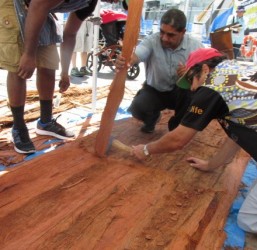 |
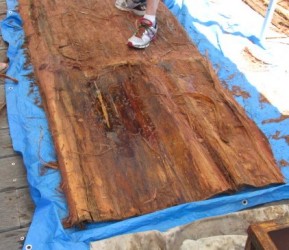 |
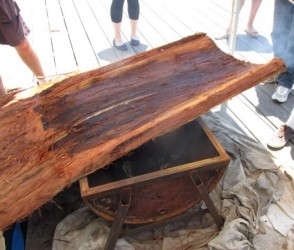 |
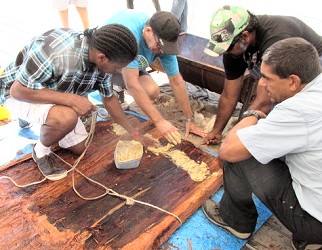 |
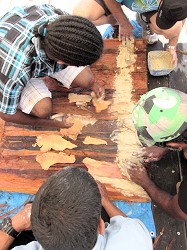 |
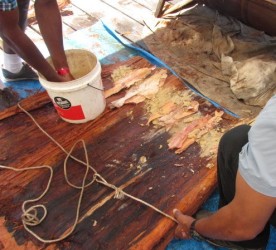 |
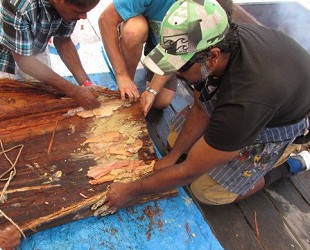 |
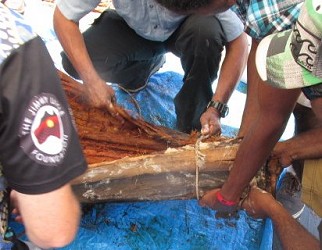 |
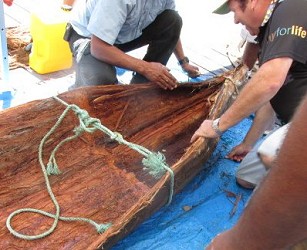 |
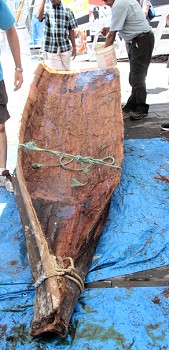 |
At this
point, the hull is rotated
and the other thinned end
now dampened and steamed
over the hearth,
another clay and paper-bark poultice added, and the folding process of replicated. With
both ends bound, the damp
clay is used as a filler
or sealer to block the
seams.
Any cracks or splits in the hull apparent after folding are likewise sealed with clay and paper-bark. 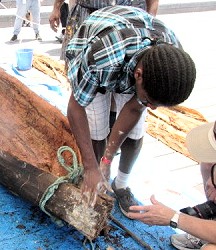 |
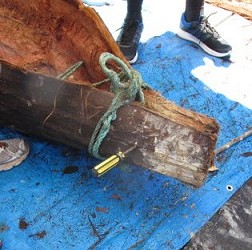 |
A
screwdriver was now forced
though the folds,
and a sharpened stick of (?) wood inserted through the hole, tightly locking the bow and stern. |
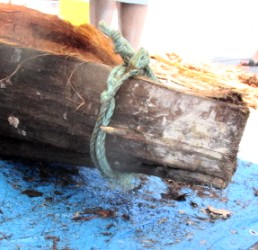 |
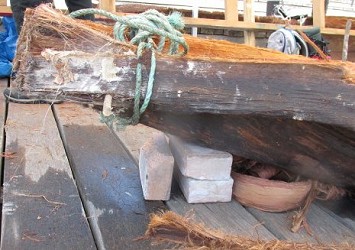 |
With both
bow and stern now tied,
plugged and pinned, the hull
was blocked with house
bricks at either end,
enhancing the waterline. The craft was now left overnight for the moisture induced by the steaming process to evaporate. Various cross struts and ties were intended to be added the following day, before launching. |
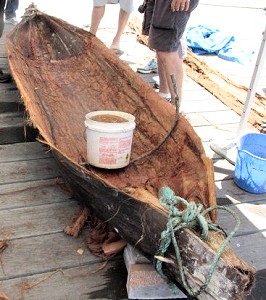 |
| Reed
Canoe Reconstruction Hobart Museum, Tasmania, c 2000. Photograph courtesy of Bob Green, April 2020. |
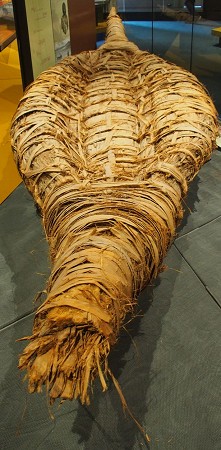 |
| 1817 Lycett, Joseph: Fishing [Port Jackson?], 1817. Aborigines spearing fish, others diving for crayfish, a party seated beside a fire cooking fish. National Library of Australia http://nla.gov.au/nla.pic-an2962715-s17 - Burnum: Burnum Burnum (1988) page 35. Note the tied-bark canoes, spear-fishing, and the three aboriginals at the left who are diving, swimming, and returning to shore with a catch of crayfish. |
 |
| 1817 Joseph Lycett: Aborigines cooking and eating beached whales, Newcastle, New South Wales, ca. 1817. National Library of Australia http://nla.gov.au/nla.pic-an2962715-s11 - Burnum: Burnum Burnum (1988) page 57 (flopped). |
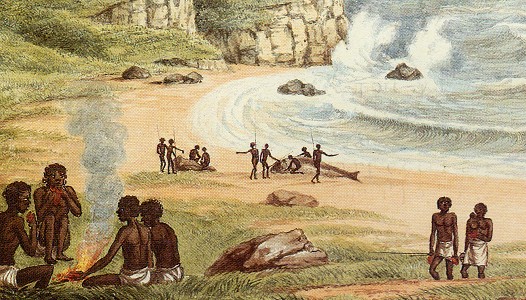 |
| Louis
Auguste de Sainson: Sharing the catch, Jervis Bay, 1826. Dumont D'Urville: Two Voyages to the South Seas Volume 1: Astrolabe 1826-1829 Translated by Helen Rosenman Melbourne University Press, 1987, facing page 91 |
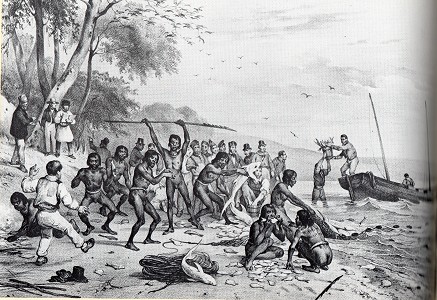 |
| 1847 George French Angas: Aboriginal fishing implements, Murray River, SA. South Australia Illustrated, South Australian Museum. - Burnum: Burnum Burnum (1988) page 246, detail and adjusted. The descriptions are yet to be confirmed. 2. Scoop net. 3. Drag net. 7. Fishing net, detail. 16. Abalone, or mutton-fish, shell. 20. Harpoon barb 21. Pole or shaft |
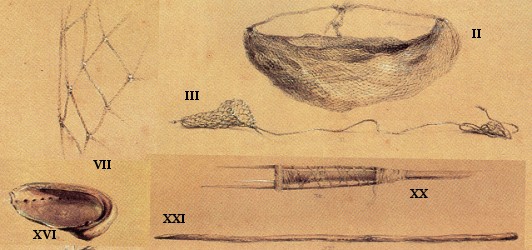 |
| 1847 Unaccredited: Natives Fishing at Port Jackson, [circa 1800]. Using a net or trap. Illustration from Ida Lee: The Coming of the British to Australia 1788 to 1829. (1906), Chapter 1, plate 8. Derived from: George French Angas: Coast Scene near Rapid Bay, Sunset Natives Fishing with nets,1847. Second Vallery, from the South Australia Illustrated series. or Samuel Calvert (1828-1913): South Australian Natives fishing- near Rapid Bay, at the Mouth of the Parananakooka Creek, 1871. From the Illustrated Sydney News (1854 to 1889) |
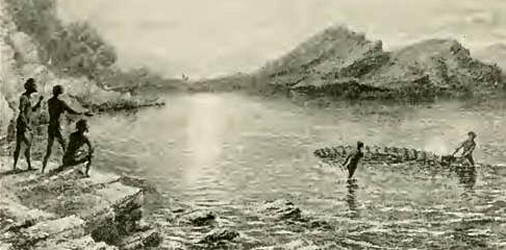 |
| 1888 Mullet Fishing [Northern Australia] Schellsberson: Garran: Picturesque Atlas of Australasia (1886-1888) page 402. |
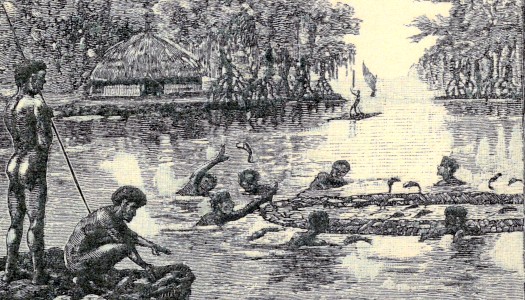 |
|
Figure 6: Fishing at
East Corrimal. ('Condon's Creek', Captain Robert
Westmacott, circa 1846, lllawarra Images)
Figure
7: Spear fishing at Tom Thumb lagoon. (Tom Thumb
Lagoon'John Skinner Prout 1840-1850, State Library
of NSW)
Figures 8: Fish spears, bone hook, woven
basket and spear thrower. (Etchings from Brough
Smyth 1878) Wesson, Sue (editor): A History of the Aboriginal people of the
Illawarra 1770 to 1970 |
|
1910
Collecting pippies on the shore near Port Macquarie. Photograph: Thomas Dick, Australian Museum. Removed by request of members of the Birpai community. - noted, with thanks, by Vanessa Finney, AM. - Burnum: Burnum Burnum (1988) page |
|
1910 Children with a catch of lung-fish, originally found only in the Mary and Burnett Rivers of south-east Queensland. Growing to some 2 metres in length, the lungfish was called a barrumundi by Aboriginal people, subsequently applied to a different fish from northern rivers. Photograph: possibly by Charles Kerry or Henry King, Australian Museum. (accreditation noted by Vanessa Finney, AM) - Burnum: Burnum Burnum (1988) page 100. |
 |
| Stone
wall fish traps, Upper
Macleay River (?) The two young Aboriginals in the foreground hold successful catches. Photograph: Thomas Dick. - Burnum: Burnum Burnum (1988) page 70. |
 |
| c1930 Fishing with scoop net or trap, Nth Queensland. Photograph: Donald Thomson, courtesy Mrs Thomson. - Burnum: Burnum Burnum (1988) page 134. The Donald Thomson Collection at Museum Victoria: http://museumvictoria.com.au/collections...donald-thomson/ |
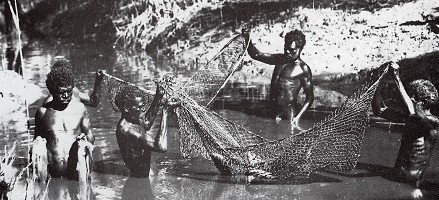 |
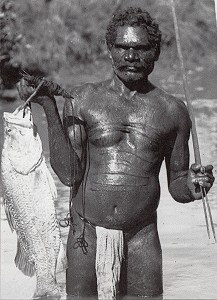 |
circa
1920 Left: Barramundi was appreciated as a fine eating fish long before the arrival of European chefs. The Australian Museum. Photograph: Frank Hurley, registration AMS320/V5217. (accreditation noted by Vanessa Finney, AM) - Burnum: Burnum Burnum (1988) page 154. Right: Turtles were a favourite delicacy of the peoples of North Queensland. Photograph: Donald Thomson, courtesy Mrs Thomson. - Burnum: Burnum Burnum (1988) page 135. |
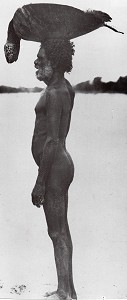 |
| 1988 Woven reed eel trap, Murray River. Museum of Victoria. Photograph: Reg Morrison - Burnum: Burnum Burnum (1988) page 273. |
 |

| home | catalogue | history | references | appendix |